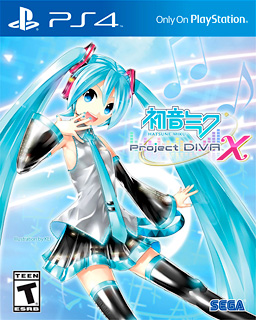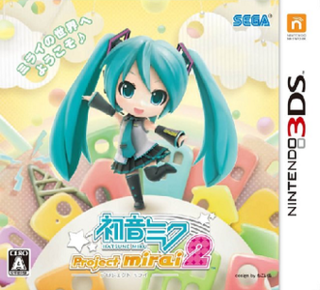 W
WHatsune Miku: Project DIVA is a series of rhythm games created by Sega and Crypton Future Media. The series currently consists of 6 main titles, released on various PlayStation consoles, the Nintendo Switch, and in arcades, the 2 Project Mirai games for the Nintendo 3DS, and 4 spin-offs for mobile and VR platforms. The series primarily makes use of Vocaloids, a series of singing synthesizer software developed by the Yamaha Corporation, and the songs created using these Vocaloids, most notably the virtual-diva Vocaloid Hatsune Miku. It is the first video game series to utilize audio created in the Vocaloid software.
 W
WHatsune Miku and Future Stars: Project Mirai is a 2012 rhythm game created by Sega and Crypton Future Media for the Nintendo 3DS. The game is a spin-off of the Hatsune Miku: Project DIVA series of Vocaloid rhythm games and was first released on March 8, 2012 in Japan with no international release. Like the original, the game primarily makes use of Vocaloids, a series of singing synthesizer software, and the songs created using these vocaloids most notably the virtual-diva Vocaloid Hatsune Miku. It is also the first Project Diva/Mirai game to include a Vocaloid made by Internet Co., Ltd. and the mascot Gumi appeared as a guest star.
 W
WHatsune Miku: Project DIVA is a 2009 rhythm game created by Sega and Crypton Future Media for the PlayStation Portable. The game was first released on July 2, 2009 in Japan with no international release. The game primarily makes use of Vocaloid, a series of singing synthesizer software, and the songs created using these Vocaloids, most notably Hatsune Miku. The game is the first video game to utilize the Vocaloid software developed by the Yamaha Corporation.
 W
WHatsune Miku: Project DIVA 2nd is a 2010 rhythm game created by Sega and Crypton Future Media for the PlayStation Portable. The game is a sequel to the 2009 video game, Hatsune Miku: Project DIVA, and was first released on July 29, 2010 in Japan with no international release. Like the original the game primarily makes use of Vocaloids, a series of singing synthesizer software, and the songs created using these vocaloids most notably the virtual-diva Vocaloid Hatsune Miku. In addition, similar to the first Dreamy Theater, a companion game Hatsune Miku: Project DIVA Dreamy Theater 2nd that allows players to play the game on the PlayStation 3 with improved visuals.
 W
WHatsune Miku: Project DIVA Arcade is a 2010 arcade rhythm game created by Sega and Crypton Future Media for arcade machines. The game is a port of the 2009 video game, Hatsune Miku: Project DIVA, with updated visuals and was released on June 23, 2010 in Japan with limited international release in countries such as Singapore. Like the original the game primarily makes use of Vocaloids, a series of singing synthesizer software, and the songs created using these Vocaloids, most notably, the virtual diva Hatsune Miku.
 W
WHatsune Miku: Project DIVA Extend is a 2011 rhythm game created by Sega and Crypton Future Media for the PlayStation Portable. The game is an expansion to the 2010 video game, Hatsune Miku: Project DIVA 2nd, and was first released on November 10, 2011 in Japan with no international release. Like the original the game primarily makes use of Vocaloids, a series of singing synthesizer software, and the songs created using these vocaloids most notably the virtual-diva Vocaloid Hatsune Miku. Rock band Gacharic Spin served as motion capture models. Similar to past games in the series, a companion game Hatsune Miku: Project DIVA Dreamy Theater Extend was released on the PlayStation 3 on September 13, 2012 with improved visuals and it also supports stereoscopic 3D for the first time in the series.
 W
WHatsune Miku: Project DIVA f is a 2012 rhythm game created by Sega and Crypton Future Media for the PlayStation Vita and PlayStation 3. The game is the fifth entry in the Hatsune Miku: Project DIVA series of Vocaloid rhythm games and was released on the PlayStation Vita on August 30, 2012. A PlayStation 3 version titled Hatsune Miku: Project DIVA F was released on March 7, 2013. The PS3 version was released physically and digitally in North America on August 27, 2013, making it the first game in the Project DIVA series to be released in the West. It was to be released in Europe at the same time, but instead released one week later, on September 4, 2013 as a digital download only title. The PS Vita version was released in North America and Europe in March 2014, both as digital download only titles as well.
 W
WHatsune Miku: Project DIVA F 2nd is a 2014 rhythm game created by Sega and Crypton Future Media for the PlayStation Vita and PlayStation 3, and is the direct sequel to Hatsune Miku: Project DIVA F. The Vita version of the game is compatible with the PlayStation Vita TV system. The game was released in Japan on March 27,
 W
WHatsune Miku: Project DIVA X is a 2016 rhythm game featuring the character Hatsune Miku, created by Sega and Crypton Future Media, released on March 24, 2016 for the PlayStation Vita in Japan. A PlayStation 4 version known in Japan as Hatsune Miku: Project DIVA X HD was released on August 25, 2016. A North American and European version has been released for PlayStation 4 and PlayStation Vita on August 30, 2016. The title reflects the game being the 10th entry in the Hatsune Miku: Project DIVA series. The game takes a new approach to play style, focusing around the theme of "Live and Produce".
 W
WHatsune Miku: Project Mirai 2 is a rhythm game created by Sega and Crypton Future Media for the Nintendo 3DS and the sequel to Hatsune Miku and Future Stars: Project Mirai. The game is also a spin-off of the Hatsune Miku: Project DIVA series of Vocaloid rhythm games and was first released on November 28, 2013 in Japan with no international release until September 2015. Like the original, the game primarily makes use of Vocaloids, a series of singing synthesizer software and the songs created using these vocaloids most notably the virtual-diva Vocaloid Hatsune Miku. It is also the second game to include a Vocaloid made by Internet Co., Ltd., Gumi. An updated version of the game was released in 2015, first in Japan as Hatsune Miku: Project Mirai Deluxe , then in North America and Europe under the title of Hatsune Miku: Project Mirai DX.
 W
WMiku Flick (ミクフリック) is a 2012 rhythm game created by Sega and Crypton Future Media for the iOS operating system for iPhone, iPad and iPod Touch. The game is a spin-off of the Hatsune Miku: Project DIVA series of Vocaloid rhythm games and was released in Japan on March 9, 2012 and internationally on April 9, 2012. Like the original the game primarily makes use of Vocaloids, a series of singing synthesizer software, and the songs created using these vocaloids most notably the virtual-diva Vocaloid Hatsune Miku. Miku Flick is the first game in the Project Diva series to ever be released outside Japan in English.